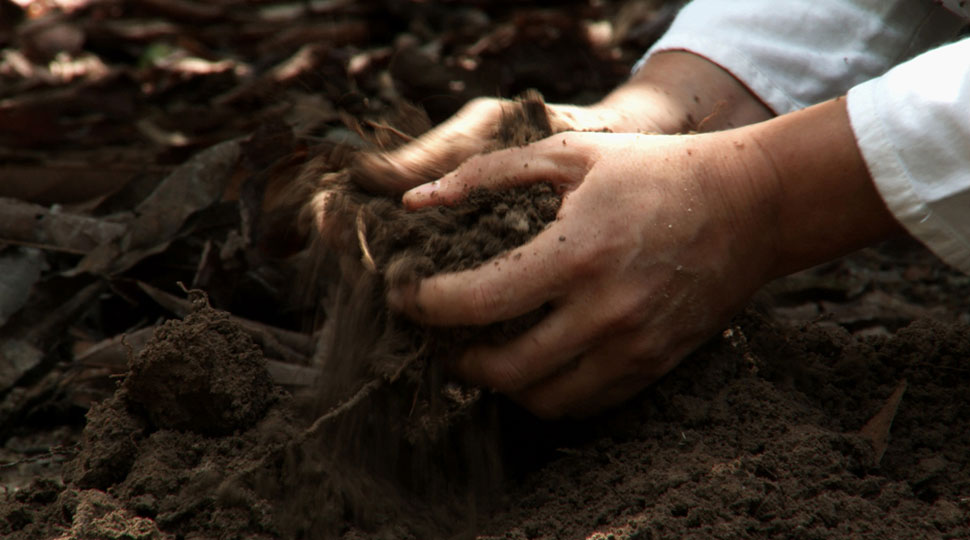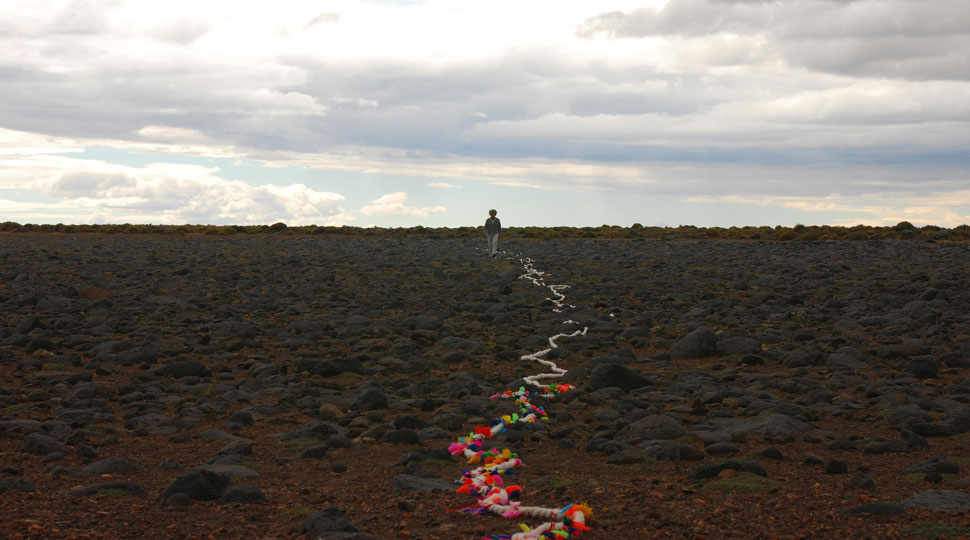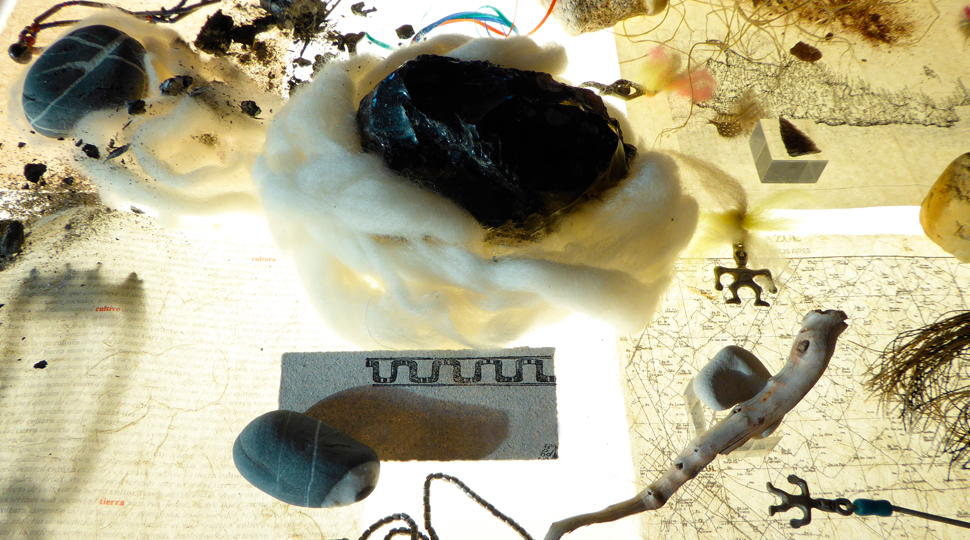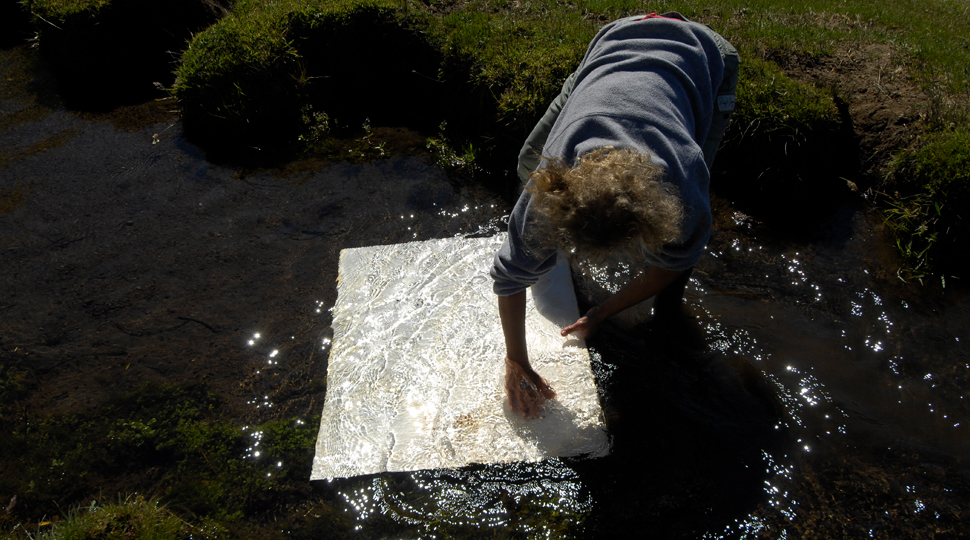Dibujos de agua
Escurrimientos de agua, tierra y carbón sobre papel
Desde 2006 Teresa Pereda ha experimentado con escurrimientos de agua mezclada con tierra y carbón sobre papel. Las imágenes que obtiene resultan de lentos procesos de drenaje que activan la fusión de las sustancias. Acontecen accidentes y decantaciones, que generan un tiempo geológico de sedimentación.
Water Drawings
Trickles of water, soil, and charcoal on paper
Since 2006, Teresa Pereda has experimented with trickles of water mixed with soil and charcoal on paper. The resulting images are produced by a slow draining process during which the substances fuse. Accidents and pouring generate a geological time of sedimentation.
Land Prints
Inmersión de papeles en espacios naturales
Desde 2006 Teresa Pereda experimenta con la inmersión de papeles en la zona de mallines cordilleranos patagónicos (humedales). Las piezas reposan suspendidas en el agua por varios días. Las imágenes que obtiene son el resultado de un conjunto de capas sensibles a la acción del agua, del aire y del tiempo orgánico que opera en la fijación de minerales y sustancias.
Land Prints
Paper prints of natural spaces
Since 2006, Teresa Pereda has experimented with wetting papers in the swamps of Patagonia, called mallines. The sheets of paper rest on the surface of the water for several days. The resulting images are produced by a series of layers that react to the water, the air, and the organic time that sets minerals and other substance on the surface of the paper.
Recolección en el bosque: cita en Yatana
Ushuaia, Argentina
I Bienal del Fin del Mundo,
2007
Acciones llevadas a cabo en el bosque de Yatana, espacio que alberga especies nativas, resiste a la urbanización y mantiene viva la memoria de los pueblos antiguos. Recolección colectiva e intercambio de tierras. Los participantes fueron invitados a tejer el bosque, echando a rodar un ovillo.
Gathering in the Forest: Appointment in Yatana
Ushuaia, Argentina
I End of the World Biennial, 2007
Actions carried out in the Yatana forest, home to native flora that has resisted urbanization and kept alive the memory of ancient peoples. Collective gathering and exchange of soils. Participants were invited to "weave" the forest by rolling a ball of wool through it.
Recolección en el salar: cita en Jaruma
Bolivia
Apacheta de la familia Quispe Flores, 2008
Acciones en consonancia con los ciclos de la naturaleza y con los habitantes del gran salar, descendientes de aymaras y quechuas.
Teresa Pereda participó de la ceremonia de "floreamiento" de las llamas, que se celebra en el mes de enero. Se prepararon las ofrendas. Los auca solicitaron que se integraran a ellas las cuatro tierras llevadas desde la Argentina. Luego la artista recibió la tierra de Jaruma de manos de los participantes, con quienes, a su vez, se floreó el ovillo.
Gathering in the Salt Flat: Appointment at Jaruma
Bolivia
Apacheta from the Quispe Flores family, 2008
Actions in keeping with the cycles of nature and with the descendants of the Aymara and Quechua peoples who live in the great salt flat.
Teresa Pereda took part in the "blossoming" of the llamas ceremony held in January. Offerings were prepared; the community's spiritual leader, or Auca, requested that the four sacks of soil brought by the artist from Argentina form part of those offerings. The artist then received soil from Jaruma from the hands of participants with whom she also adorned the ball of yarn with "flowers" made of thread.
Recolección en la Amazonia: Cita en Morena, Brasil
Casa de Ester Oliveira da Costa, 2008
Acciones en consonancia con los ciclos de la naturaleza, las leyendas populares amazónicas y sus narradores, los caboclos (mestizos de blanco europeo con indígena americano).
Teresa Pereda registró leyendas locales (lendas) e intercambió tierras en una huerta de agricultores de hierbas medicinales. Con la ayuda de los lugareños, echó a rodar por la floresta un ovillo, que luego fue introducido en un río, donde el torrente lo sumergió y disgregó.
Gathering in the Amazon: Appointment in Morena, Brazil
Home of Ester Oliveira da Costa, 2008
Actions in keeping with the cycles of nature, legends told by bards from the Amazon region, and caboclos (people of mixed European and Indigenous heritage).
Teresa Pereda registered local legends (called lendas) and exchanged soil in a medicinal-herb farm. With the help of locals, she rolled the ball of yarn through a dell after which it was immersed in a river to then be pulled under and ripped apart by the gushing water.
El libro de las cuatro tierras, 1996-1998
Libro de papel hecho a mano con pulpa de algodón y tierras recolectadas en las provincias de Córdoba, Buenos Aires, Misiones y Neuquén.
…este libro implicó dos años de preparación y trabajo, en un intento de abarcar la totalidad del país. Mi deseo era ubicar a aquellas personas que fuesen vínculo entre el pasado y el presente de su tierra.
Fondo Nacional de las Artes, 24 ejemplares.
The Book of the Four Soils, 1996-1998
Book with pages hand made from cotton pulp and soil gathered in the Argentine provinces of Córdoba, Buenos Aires, Misiones, and Neuquén.
… I worked on this book for two years in an attempt to encompass the entire country. I wanted to include and locate persons who acted as a bridge between their land’s past and present.
Fondo Nacional de las Artes, 24 copies.
Bajo el nombre de Juan, 1998 – 2001
Teresa Pereda pensó este libro con la experiencia de quien vive en el “borde”, donde todo está al revés: las estaciones, el frío y el calor, el remolino de agua, las fases de la Luna. Esta obra implicó un programa de investigación y de trabajo de campo vinculado al viaje, la ceremonia, la palabra, la vivencia y la tierra.
Arte Dos Gráfico, Bogotá. 70 ejemplares. Libro impreso, litografías, gofrados, serigrafía, originales fotográficos y estuche contenedor.
In the Name of Juan, 1998 – 2001
For this book, Teresa Pereda looked to the experience of someone who lives on the “verge”, a place where everything is upside down (the seasons, the direction the water drains, the phases of the moon). Research and fieldwork for the book entailed travel, ceremony, engagement with language and the land, and lived experience.
Arte Dos Grafico, Bogotá. 70 copies. Printed book with lithographs, embossments, silkscreens, original photographs, and case.
1518 kilómetros
de devociones
Diciembre de 2001: la Argentina fue sacudida por una profunda crisis económica, social y político. A modo de acompañar este doloroso proceso del que todos los argentinos formamos parte, el 15 de enero 2002 emprendí un viaje.
Rollo impreso contenido en caja de aluminio, 8 ejemplares.
December, 2001: Argentina was in the throes of a major economic, social and political crisis. As a way of accompanying this painful process that involved all Argentines, on January 15, 2002, I set out a journey.
Printed roll in aluminium box, 8 copies.
4000 centímetros de aire y tierra, 2003
Cuatro cajas de madera y vidrio, caja contenedora.
Esta obra integra la operación estética de Horacio Zabala 4000 cm3.
Four wood and glass boxes, box to hold them.
This piece forms part of the aesthetic operation by Horacio Zabala entitled 4000 cm3.
Itinerario de un país. Libro-e de artista, 2009
Libro-e realizado en Editorial de Experimentación Virtual de REDgaleria - www.redgaleria.com junto con una edición facsimilar CD-ROM de 50 ejemplares. Desarrollado a partir del proyecto Itinerario de un país (1996-2006) con la premisa de visitar y solicitar tierra, a líderes populares y protagonistas calificados (chamanes, sabios y ancianos), vínculo con lo ancestral, totalizadores de la diversidad regional, étnica y lingüística de la Argentina.
Journey of a Country Artist’s e-book, 2009
e-book produced by the Experimentación Virtual press run by REDgaleria www.redgaleria.com. Fifty copies of a CD-ROM facsimile edition were also produced. The publication is based on the project Journey of a Country (1996-2006) that consisted of visiting different sites in Argentina to request soil from community leaders (shamans, wise men, elders) who act as ties between the community’s present and past. The idea was to encompass Argentina’s entire territory in all its ethnic and linguistic diversity.
Humus. La piel no calla
Video–instalación para sitio específico MNAD, Buenos. Aires. (2013) – Bienal Sur, Porto Alegre (2017)
Instalada en el espacio del salón de baile del Museo Nacional de Arte Decorativo de Buenos Aires y en el Planetario de Porto Alegre por BIENALSUR y Universidade Federal do Rio Grande do Sul. La obra genera un contrapunto respecto de la naturaleza y el espacio urbano. El sonido se construye a partir del desplazamiento de las partículas en sincronía con registros sonoros de la ciudad. Naturaleza versus vida cotidiana. Ambas pulsan, ninguna calla.
Humus: The Skin Does Not Keep Silent
Site–specific video installation
Museo Nacional de Arte Decorativo (MNAD), Buenos Aires, 2013/Bienal Sur, Porto Alegre, Brazil, 2017
Installation in the dance hall of the Museo Nacional de Arte Decorativo in Buenos Aires and in the Planetarium in Porto Alegre for the Bienal Sur. The work generates a counterpoint between nature and the urban space. The sound is constructed through the movement of particles in synch with registers of the city’s sounds. Nature versus daily life–both pulsate, neither keeps silent.
Itinerario de un país, 1996 – 2006
Instalación. Proyección lumínica, fotografía y tierras de ocho regiones de Argentina
Partiendo de la premisa de recorrer distancias sociales y sumar la diversidad regional, étnica y lingüística, Teresa Pereda emprendió un conjunto de acciones de intercambio de tierras que dieron inicio al proyecto Itinerario de un país. La tierra evoca a las personas que hicieron su generosa entrega, resultando una cartografía sensible del territorio.
Journey of a Country, 1996–2006
Installation. Lights, photographs, and soil from eight regions of Argentina
Teresa Pereda set out to travel social distances and bridge regional, ethnic, and linguistic differences. To that end, she undertook a series of exchanges of soils in what would become Journey of a Country. The soil that the artist generously received was used to produce an affective map of the territory.
Recolección – restitución. Citas por América.
Sala Cronopios, CCR, Buenos Aires (2010)
Conjunto de instalaciones. Fotografía, video, tierra y lana. Materiales que acompañaron los ritos de restitución que Teresa Pereda llevó a cabo con lugareños de Tierra del Fuego (2007); Salar de Uyuni, Bolivia, y Amazonia, Brasil (2008). Durante la muestra se realizaron acciones con la participación espontánea del público.
Gathering–Restitution. Appointments in the Americas
Cronopios gallery, Centro Cultural Recoleta, Buenos Aires, 2010
A set of installations with photographs, video, soil, and wool–the materials that formed part of the restitution rituals that Teresa Pereda performed with locals in Tierra del Fuego (Argentina, 2007); the Uyuni Salt Flats (Bolivia,2008); and the Amazon (Brazil, 2008). The public spontaneously took part in actions organized over the course of the exhibition.
Sueño de un por–venir
Malvinas. Palais de Glace, Buenos Aires (2012)
Espacio lumínico que el público transita. Se realizaron entregas de tierra y lana e intercambios espontáneos con los visitantes. La silueta del mapa de la Argentina se despliega bajo la cruz de los cuatro lugares, Meli Huitran Mapu, dimensión geográfica y cósmica. Signo que moviliza a transitar el dolor poniendo en acción las fuerzas anticipatorias de otro porvenir.
Dreams of a Here–After
Malvinas/Falklands. Palais de Glace, Buenos Aires, 2012
Viewers walked through a space with a light installation where they were given soil and wool in exchange for objects they had been invited to bring. The Argentine map was traced under the Mapuche Meli Witran Mapu cross that signals the geographic and cosmic dimensions of four directions, a sign that mobilizes by enacting the forces that anticipate another future.
Tierra
Teresa Pereda recolecta tierras en diferentes zonas geográficas: suelos arenosos, calizos, limosos, humíferos, arcillosos, pedregosos, de turba y salinos. Procesa el material por medio de deshidratación en horno, molido en mortero y filtrado en tamiz. Obtiene diferencias cromáticas, de volumen, peso y textura. Incluye tierra en la fabricación de papel hecho a mano y en la construcción de objetos, instalaciones y acciones performáticas.
Earth
Teresa Pereda gathers soil in different geographic regions and with different characteristics (sandy, limey, damp, clayey, rocky, mossy, and salty). She dries the soil in a kiln, grinds it with a mortar, and sieves it. Differences in color, volume, weight, and texture emerge. She uses the soil to make paper and construct objects, and in her installations and performative actions.
Lana
Teresa Pereda incluye la lana, torzada, tendida, enlazada, como un todo significativo en su dinámica performática. A partir de la modalidad del ritual, poseedora de energía vital, la lana se manifiesta como materia esencial para acceder a un espacio mágico. Se adapta, blanda, a la aspereza y a la distancia para unir, vincular, desplazarse, rodar.
Wool
In her performances, Teresa Pereda uses wool that is coiled, stretched, and woven into a meaningful whole. Through a ritual–like action, wool, holder of vital energy, is manifested as an essential means to a magic space. Malleable, it works through harshness and distance to join, bind, displace, and roll.
Agua
Teresa Pereda experimenta sobre papel y metal con diversas técnicas de escurrimiento de agua y sedimentación de tierras, cenizas y carbones. Durante este proceso implementa distintas dinámicas de aceleración y desaceleración del agua, resultando un conjunto de fenómenos geológicos que finalmente constituyen la obra.
Water
Teresa Pereda experiments on paper and metal using different water–trickling procedures and soil–, ash–, and charcoal–sedimentation techniques. The process entails different speeds (the water is made to move faster or slower). The resulting geological–like phenomena are what constitute the work.
Paisaje
A partir de la interacción con el paisaje y la inmersión de papeles en la zona de mallines –humedales– patagónicos, Teresa Pereda obtiene imágenes que resultan de un conjunto de capas sensibles a la acción del agua, del aire y de los procesos orgánicos. Las piezas reposan en el agua por varios días y el paisaje se traslada al papel en una suerte de fotografía de la superficie líquida.
Landscape
Teresa Pereda produces images by interacting with the landscape, specifically by wetting sheets of paper in the swamps of Patagonia, called mallines. The images are yielded by a series of layers that react to the water, the air, and organic processes. The works rest on the water for a number of days and the landscape is rendered on the paper in a sort of photograph of its surface.





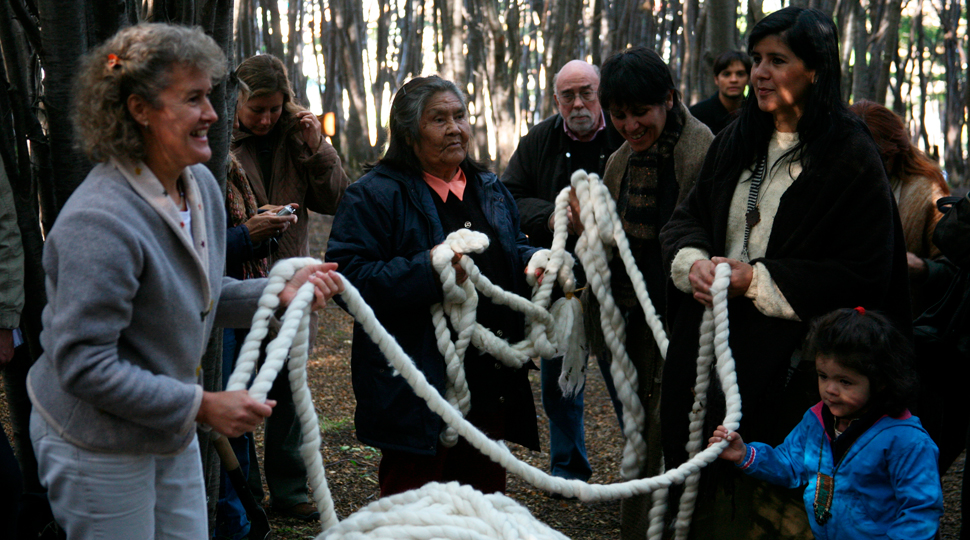
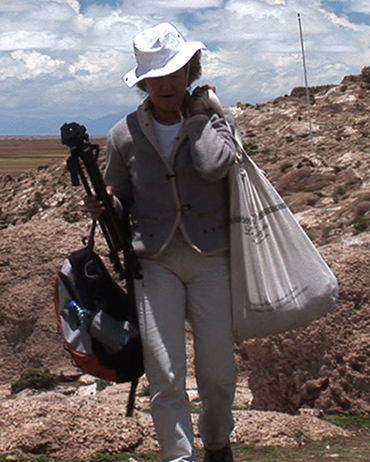
Recolección en los campos de hielo: cita en el glaciar
Campo de Hielo Sur, Argentina-Chile, 2010
Acciones en consonancia con los ciclos de la naturaleza y el paisaje patagónico.
Teresa Pereda construye un pequeño glaciar, ofrenda de hielo y escenario en el que transcurren las acciones. Un ovillo de lana ingresa, errante, al glaciar y reposa, para luego desplomarse. Cuatro tierras entregan color y materia al espacio blanco. La energía que emana del glaciar se convierte, por intención de la artista, en un espacio ritual y un encuentro mágico con la naturaleza.
Gathering in the Ice Fields: Appointment at the Glacier
Southern Ice Field, Argentina-Chile, 2010
Actions in keeping with the cycles of nature and the Patagonian landscape.
Teresa Pereda built a small glacier–an ice offering and the setting where the actions would take place. A ball of wool rolled over the glacier, came to a stop, and then fell off the side. Soil from four different places gave the white space color and materiality. The energy the glacier emitted was turned, by the artist’s design, into a ritual space and a magic encounter with nature.
Recolección en el Parque: cita país
Parque de la Memoria, Buenos Aires, 2013
Performance realizada en colaboración con familiares de desaparecidos, integrantes de pueblos originarios y excombatientes de la Guerra de Malvinas. Iniciación de la ceremonia: Luis Eduardo Pincén y Amalia Vargas. Ofrendas: Claudia Contreras, Beatriz Pichi Malén y Daniel Ontiveros, quienes representan grupos sociales víctimas de la violencia de Estado. Juntos, hicieron rodar un gran ovillo, dando un nuevo sentido a las historias de vida, desde el arte y la política.
Gathering in the Park: Appointment with the Country
Parque de la Memoria, Buenos Aires, 2013
Performance in collaboration with relatives of those disappeared during the military dictatorship (1976-1983), members of Indigenous peoples, and veterans of the Malvinas/Falklands War. Luis Eduardo Pincén and Amalia Vargas began the ceremony; offerings by Claudia Contreras, Beatriz Pichi Malín, and Daniel Ontiveros, representatives of social groups singled out as victim of state terrorism. Together, they rolled a large ball of yarn to give life stories new meaning through art and politics.
Recolección por las calles: Cita ciudad
Palermo, Buenos Aires (2018) – Lower East Side, New York (2019)
Acciones en consonancia con el paisaje urbano.
La performance The walk se llevó a cabo en el área circundante al centro de arte The Clemente en la ciudad de Nueva York, en Lower East Side, Manhattan, y en el barrio de Palermo, en la ciudad de Buenos Aires. Ambas acciones contaron con intercambios participativos de los transeúntes, ganando terreno por sobre las habituales modalidades de convivencia violenta propias de la calle. Durante la caminata, la artista facilita el decurso, y el ovillo convoca a aquellos que encuentra en su camino. Transforma y es transformada, portando la capacidad de contener lo que sucede.
Gathering in the Streets: Appointment with the City
Palermo, Buenos Aires (2018)–Lower East Side, New York (2019)
Action in keeping with the urban landscape.
The performance The Walk took place in the area surrounding The Clemente Arts Center on the Lower East Side of Manhattan and in the Palermo neighborhood of Buenos Aires. Both actions involved participative engagement with passersby to counter the habitual and violent ways the streets are usually inhabited. The artist rolled the ball of yarn, which drew the attention of those it happened upon. The ball transformed and was transformed thanks to its ability to take in whatever happened.
Itinerarios
Conjunto de itinerarios planificados iniciados por Teresa Pereda en la década del 90. El proyecto Citas por América revisita la historia, las costumbres y la iconografía de cada lugar. Dentro de esta programación realiza trabajos de campo y registros de autor que le permiten identificar a aquellas personas que son signo y vínculo entre el pasado y el presente, en una suerte de cartografía sensible del territorio.
Journeys
The Appointments in the Americas project consists of a series of journeys Teresa Pereda began in the nineteen-nineties. The project reexamines each location’s history, customs, and iconography. During these visits, the artist engages in fieldwork to identify those individuals that act, on symbolic and lived levels, as bridges connecting the past and the present to build a sort of affective map of the territory.
Aquí se detuvo el agua
Escurrimientos de agua y tierra sobre chapa de hierro
"La poética, la identidad y la sustancia de la obra de Teresa Pereda resultan de la tierra (su opacidad y resistencia) y del agua (su fluidez y transparencia) […] En este proceso la artista fija sobre el metal las manchas (irregulares) y los signos (inacabados) de la alquimia tierra-agua. Esto significa registrar las huellas del lento proceso de descomposición y recomposición que animan los ciclos de la naturaleza". Horacio Zabala, 2005.
Water Stopped Here
Trickles of water and soil on iron plate
Teresa Pereda's art-its poetics and identity, its very substance-is the product of the earth (its opacity and resistance) and of the water (its fluidity and transparency) […] The artist captures on metal plates the (irregular) blotches and the (unfinished) signs of the earth-water alchemy. That means registering the traces left by the slow process of decomposition and recomposition that engine nature's cycles. Horacio Zabala, 2005
Erupción
Escurrimientos de agua, cenizas volcánicas, tierra y carbón sobre acero
A partir de la cadena de erupciones producidas, en el sur de Argentina y Chile, por el complejo volcánico Puyehue, en junio 2011, Teresa Pereda inició, a modo de estallido, una serie de trabajos en acero. Sobre grandes láminas derramó agua, cenizas del volcán, tierras y carbones que reflejan el rastro de las actividades eruptivas. Ejercicios geológicos, emisiones lávicas que accionan a partir de las fuerzas de lo desconocido.
Eruption
Trickles of water, volcanic ash, soil, and charcoal on steel plate
Pursuant to a chain of eruptions of the Puyehue volcanos in southern Argentina and Chile in June 2011, Teresa Pereda "exploded" a series of works on steel. She poured water, volcanic ash, soil, and charcoal on large steel plates in order to reflect the dynamics of an eruption. Geological exercises, larval emissions set off by the forces of the unknown.
Luz
BIENALSUR Porto Alegre, Brasil (2017)
Espacio lumínico que el público transita. La artista realizó entrega de tierras y lana e intercambios colectivos espontáneos. La silueta del mapa de Latinoamérica se despliega bajo la cruz de los cuatro lugares, Meli Huitran Mapu, dimensión geográfica multidimensional. Tiempo de conciliación concerniente al territorio americano que nos involucra.
Light
BIENALSUR, UFRGS, Porto Alegre, Brazil, 2017
Viewers walked through a space with a light installation where they were given soil and wool in exchange for objects they had been invited to bring. The map of Latin America was traced under the Mapuche Meli Witran Mapu cross that signals four directions in a multidimensional geography. Time of reconciliation with the American territory in which we ourselves are implicated.
Personas
Las acciones de Teresa Pereda surgen como extensión y despliegue de sus itinerarios, en consonancia con el mundo indígena, en tanto evocan saberes ancestrales. Realiza diversas acciones con las personas de cada lugar: intercambio de tierras, entretejido y ovillado de lana. Las condiciones geográficas y la interacción con la gente confluyen en un espacio simbólico.
People
Teresa Pereda's actions in situ are a logical extension of her journeys. They are in keeping with the Indigenous world insofar as they draw on ancestral wisdom. She engages in different actions with the people in each place: the exchange of soils, weaving and spooling wool, etc. The landscape, with its specific characteristics, and interaction with people converge in a symbolic space.
Origen
Desde su infancia, Teresa Pereda ha mantenido contacto con el mundo indígena. A partir de un amplio aprendizaje del complejo ceremonial–ritual, fue conformando una narrativa que evoca ceremonias y saberes ancestrales. Integra la comunidad günün ä küna–mapuche Vicente Catrunao Pincén, abocada a un proceso de reetnización. Juntas viajan dos veces al año a participar en las rogativas de las comunidades picunches del Neuquén.
Origin
From the time she was a child, Teresa Pereda has had close contact with the Indigenous world. Thanks to the knowledge that, through an array of learning processes, she has acquired of ceremonies and rituals, she has constructed a narrative that draws on ancestral wisdom. She forms part of the Vicente Catrunao Pincén günün ä küna–mapuche community that advocates re–ethnicization. She travels to Neuquén province twice a year to participate in the ceremonies of the local Picunche community.
